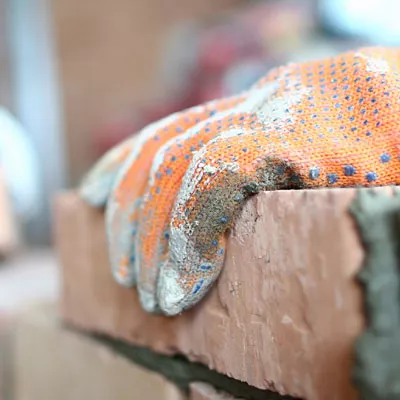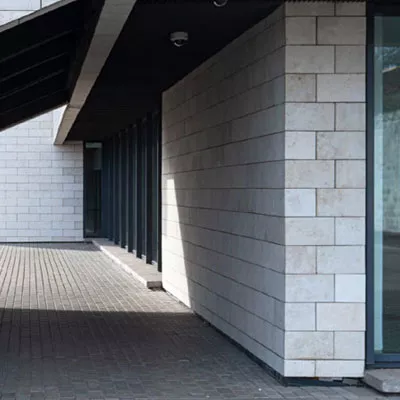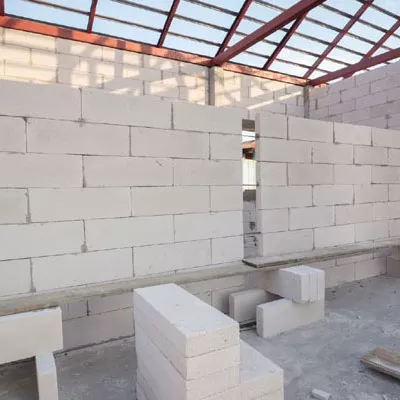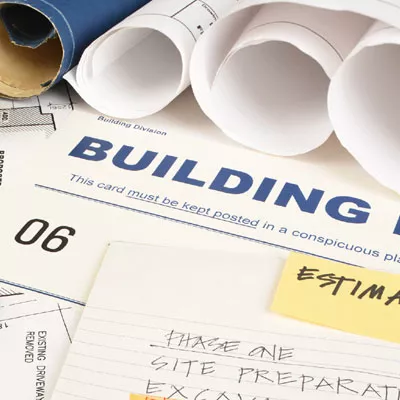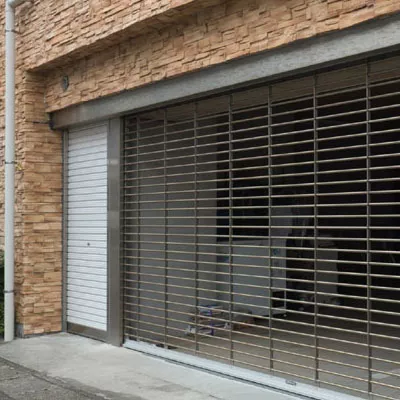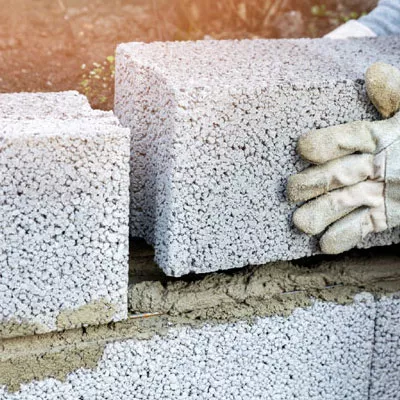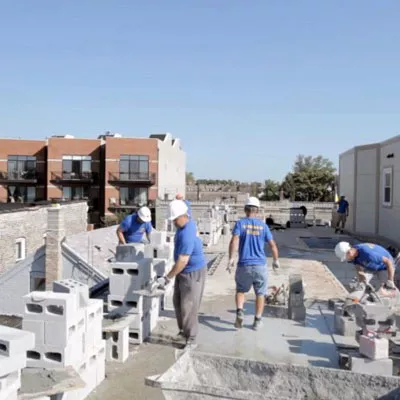Cinder block wall
Cinder Block Walls: Build With Masonry Chicago
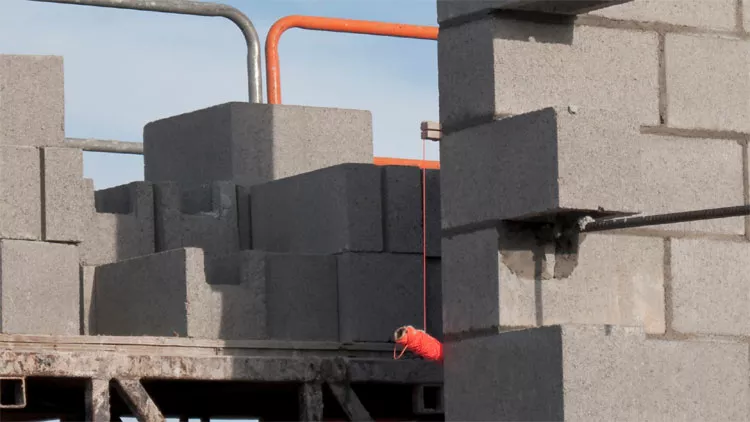
Build With Cinder Block Walls & Get a Reliable Result, Fast
Cinder block walls are widely used in residential and commercial construction. They are made from hollow cinder blocks — concrete masonry units of a standard rectangular shape, an affordable alternative to brick, natural stone, or concrete blocks. Cinder blocks are produced from a mixture of concrete and ash (coal cinders). This makes this block wall light, easy to assemble — and to be used for multiple purposes.
Here at Masonry Chicago, we have been in block construction for more than 20 years. Our portfolio contains many cinder block wall projects that we are truly proud of. Planning one yourself? Give us a call on 773-231-5371 and get a free estimate or ask any questions to our experienced builders!
What is a cinder block wall?
Cinder block walls contain stackable concrete masonry units (CMU) and are used for exterior and interior walls construction. Concrete blocks and cinder blocks are available in varying shapes to suit various applications. Retaining walls are often built from cinder blocks. The dimensions of the blocks can vary depending upon the engineering specifications or design parameters, but in one project the builder is most likely to use the same types of blocks. In case needed, a half block can be used, for example, for the finishing touches of a cement wall.
Family-Owned Company. 20 Years of Masonry Expertise
Cinder block wall: what it can be used for?
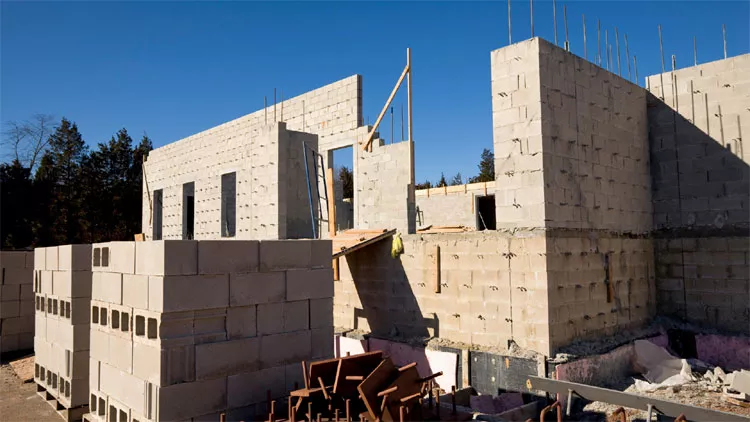
- Non-bearing wall (exterior/interior)
- Retaining wall (residential/commercial building)
- Separation wall
- Garden wall
- Landscaping
- Foundation inside ready-made structures
Anatomy of a block wall
Concrete walls are created from concrete blocks. Mortar holds the components together, with the help of the special wet concrete mixture. Usually, concrete and cinder blocks measure approximately 8 inches long by 8 inches high, and the concrete web divides the inside area into small hollows. All concrete structures should be supported for stability: some of the walls require 1/2-inch steel reinforced bars (or rebar) running horizontally or vertically.
Multipurpose use of block walls
Virtually, each block wall built with CMUs shares a similar structure, but their applications may vary dramatically according to the dimension and shape of the blocks. Concrete blocks are generally used in the construction of single walls, built from single-wide rows. If a stronger structural foundation is needed, it is possible to build double-walled walls with two strands of the concrete block.
Cinder blocks application is similar: if you need a wider wall, you can easily create double-wide rows from it. But keep in mind, that it cannot be a bearing wall — use it for something like a retaining wall, a beautiful patio wall, etc.
- 20years of Masonry Expertise
- 50+professional bricklayers
- 300+masonry and tuckpointing projects
Ready to start your masonry project?
Cost of Concrete Block Wall Installation in Chicago
Cinder block wall vs concrete block walls

- Cinder blocks are lighter than concrete blocks
- A cinder block wall is not as strong as the one, made of concrete block
- Cinder blocks are not used in building foundations: they cannot withhold heavyweights
- A cinder block wall is mostly chosen by builders for the projects of the smaller scale
- A concrete block can be used in large residential or commercial projects
- Concrete block is more expensive than cinder block
Step-by-step instructions for building with a cinder block or concrete wall
Create layouts
The first stage for building a concrete block wall involves setting up the foundation through stakes or string. In the case of landscape walls, this requires creating simple rectangular outlines of the plan. Generally, the foundation construction requires a rectilinear shape and careful adjusting for a perfect square. The location of the foundation (remember, that we use cinder blocks only for non-bearing constructions?) has to be determined before the major construction process begins.
Cut blocks
Depending on your planning, you can cut cinder blocks, but it can be done using a saw that comes with a stone ax, as well as a mortar and hammer. Use your power saw to cut a 1/4 inch wide line. Use masonry chisels for hammering along the line until the blocks are cleaved from the line. Turn the block over and repeat on the other side.
Lay subsequent courses of blocks
Start the layout in blocks: with half blocks to keep vertical joints offset throughout the way. Install the second course, comparing and fitting it with the first one — by putting wet mortar over the base of the last course, and adding it to the end of the line. Masonry string and level are often utilized to check the course for leveling. Excess mortar is easily pulled out using a towel as you work.
Add reinforcement
When moving up, the addition of steel reinforcement is required. During any three-way or 4-track course, the horizontal joints should be supported with metal reinforcement strips placed in a mortar before the formation of the next block. Vertical reinforcement hollow cavities are filled with metal reinforcements. This improves vertical strength within block rows and the overall structure. Check out your local legal regulations for the horizontal wall support.
Finish the joints
Depending upon the scale and speed of your project, you may occasionally need to smooth and finish a joint. After the mortar is installed, but before it is completely hardened, the finishing joints process is done first. Use an edge tool to press the tool gently into the mortar, while drawing the tool on the joint. The tool must be slightly enclosed in the mortar joint.
Over 300 Projects in Chicago and Suburbs
1111
Build cinder block fences
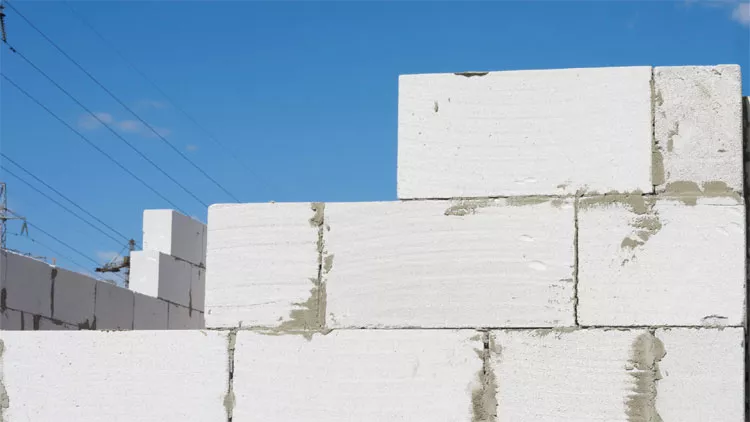
Cinder blocks are often used in fence construction. Costs to install cinder blocks are between $10-$15 per square foot for the simple styles of fences. If you’re from southwestern America you’re probably familiar with the construction of concrete-walled fences with scaly knees. They are used to protect the house and prevent fires. Block fences are an affordable alternative to costly brick fences. But their construction requires a competent contractor for the calculation of the load-bearing capacity.
When to build a cinder block or concrete block wall?
The excavation of the concrete floor of the concrete block walls and the cure and maintenance of the mortars is the only weather-dependent part of a project. When the ground is frozen, then you cannot dig manually or extreme cold can affect the mortar’s curing. Otherwise, walls can be constructed anytime of the year or virtually anywhere.
Permits and local building codes
The construction of concrete walls most likely requires official permission. Contact your local building department for information about the permits — or inquire about this information from your builder. Even if your neighborhood is free of zoning permits, the walls may still need zoning approval. Consult your city council for the regulations in your area.
Frequently Asked Questions
Is it cheaper to build a cinder block building?
It depends on what we are comparing it with. A cinder block building is definitely cheaper than a brick building, or one that is constructed from natural stone.
Can I build a house out of cinder blocks?
Sure you can! And it will be a more affordable option than building from concrete blocks, brick, wood, or natural stone.
How much does it cost to build with cinder blocks?
An average cost of a single cinder block is $1 – $3. A typical 6′ x 15′ wall costs around $1000 – $2500.
Are cinder blocks good for walls?
Cinder blocks are good for walls in buildings of any type and are suitable for DIY projects in your home too. Need ideas or have a project in mind? Call Masonry Chicago today on 773-231-5371 and get a free consultation or a quote!
Look at
The Results of Our Masonry Works:
Building with a difference. Before and After:





